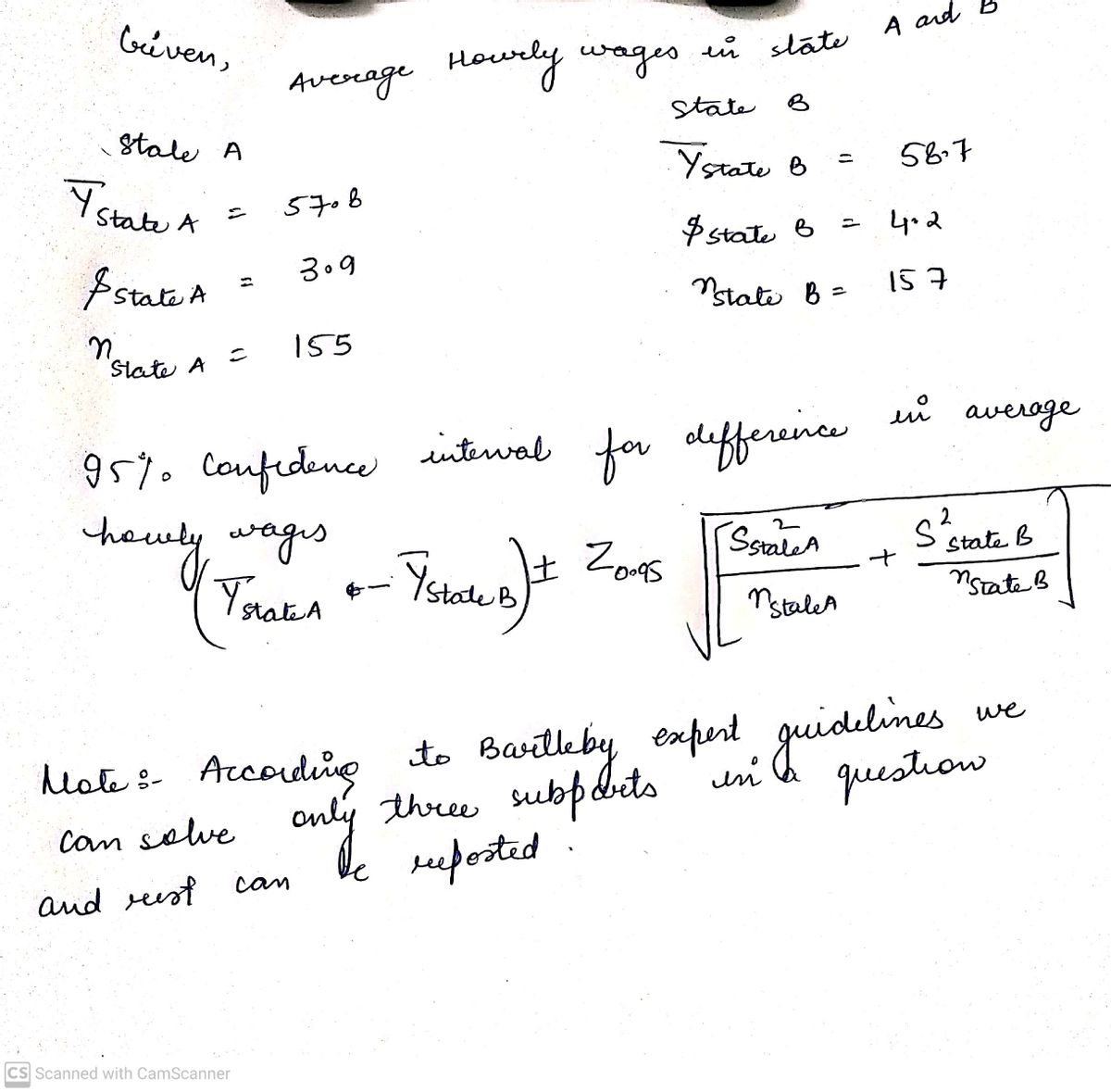Suppose that you were told that average hourly wages in State A and State B are different. However, you have your own suspicion that it could be the same. You suggest to your brother, who is attending a school in State B to collect data on hourly wage as part of your project You do the same for State A as your school is located in State A. The accompanying table shows your and your brother's findings. Average Hourly Wages in State A and State B, in dollar State A State B Ystate a Sstate a | nstate A Ystate B Sstate B Nstate B 58.7 155 57.8 3.9 4.2 157 (a) Let your null hypothesis be that there is no difference in the average hourly wage in the two states. Specify the alternative hypothesis. (b) Find the difference in average hourly wage and the standard error of the difference. Generate a 95% confidence interval for the difference in average hourly wage. Calculate the t-statistic for comparing the two means. Is the difference statistically significant at the 1% level? Which critical value did you use? Why would this number be smaller if you had assumed a one-sided alternative hypothesis? What is the intuition behind (d) this? What about at 5% level? (e)
Suppose that you were told that average hourly wages in State A and State B are different. However, you have your own suspicion that it could be the same. You suggest to your brother, who is attending a school in State B to collect data on hourly wage as part of your project You do the same for State A as your school is located in State A. The accompanying table shows your and your brother's findings. Average Hourly Wages in State A and State B, in dollar State A State B Ystate a Sstate a | nstate A Ystate B Sstate B Nstate B 58.7 155 57.8 3.9 4.2 157 (a) Let your null hypothesis be that there is no difference in the average hourly wage in the two states. Specify the alternative hypothesis. (b) Find the difference in average hourly wage and the standard error of the difference. Generate a 95% confidence interval for the difference in average hourly wage. Calculate the t-statistic for comparing the two means. Is the difference statistically significant at the 1% level? Which critical value did you use? Why would this number be smaller if you had assumed a one-sided alternative hypothesis? What is the intuition behind (d) this? What about at 5% level? (e)
MATLAB: An Introduction with Applications
6th Edition
ISBN:9781119256830
Author:Amos Gilat
Publisher:Amos Gilat
Chapter1: Starting With Matlab
Section: Chapter Questions
Problem 1P
Related questions
Question
Thank you!

Transcribed Image Text:Suppose that you were told that average hourly wages in State A and State B are different.
However, you have your own suspicion that it could be the same. You suggest to your brother,
who is attending a school in State B to collect data on hourly wage as part of your project
You do the same for State A as your school is located in State A. The
accompanying table shows your and your brother's findings.
Average Hourly Wages in State A and State B, in dollar
State A
State B
Ystate A Sstate A Nstate A Ystate B Sstate B Nstate B
57.8
3.9
155
58.7
4.2
157
(a)
Let your null hypothesis be that there is no difference in the average hourly wage in
the two states. Specify the alternative hypothesis.
(b)
Find the difference in average hourly wage and the standard error of the difference.
(c)
Generate a 95% confidence interval for the difference in average hourly wage.
(d)
Calculate the t-statistic for comparing the two means. Is the difference statistically
significant at the 1% level? Which critical value did you use? Why would this number be
smaller if you had assumed a one-sided alternative hypothesis? What is the intuition behind
this?
(e)
What about at 5% level?
Expert Solution
Step 1

Trending now
This is a popular solution!
Step by step
Solved in 4 steps with 4 images

Recommended textbooks for you

MATLAB: An Introduction with Applications
Statistics
ISBN:
9781119256830
Author:
Amos Gilat
Publisher:
John Wiley & Sons Inc

Probability and Statistics for Engineering and th…
Statistics
ISBN:
9781305251809
Author:
Jay L. Devore
Publisher:
Cengage Learning

Statistics for The Behavioral Sciences (MindTap C…
Statistics
ISBN:
9781305504912
Author:
Frederick J Gravetter, Larry B. Wallnau
Publisher:
Cengage Learning

MATLAB: An Introduction with Applications
Statistics
ISBN:
9781119256830
Author:
Amos Gilat
Publisher:
John Wiley & Sons Inc

Probability and Statistics for Engineering and th…
Statistics
ISBN:
9781305251809
Author:
Jay L. Devore
Publisher:
Cengage Learning

Statistics for The Behavioral Sciences (MindTap C…
Statistics
ISBN:
9781305504912
Author:
Frederick J Gravetter, Larry B. Wallnau
Publisher:
Cengage Learning

Elementary Statistics: Picturing the World (7th E…
Statistics
ISBN:
9780134683416
Author:
Ron Larson, Betsy Farber
Publisher:
PEARSON

The Basic Practice of Statistics
Statistics
ISBN:
9781319042578
Author:
David S. Moore, William I. Notz, Michael A. Fligner
Publisher:
W. H. Freeman

Introduction to the Practice of Statistics
Statistics
ISBN:
9781319013387
Author:
David S. Moore, George P. McCabe, Bruce A. Craig
Publisher:
W. H. Freeman